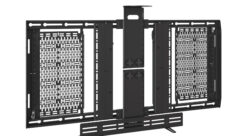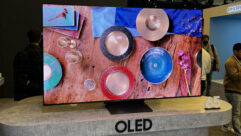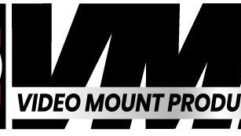

With Flat-Panels, Simpler Is Usually Better
Recently, I was invited to speak before the local chapter of the Society of Cable Telecommunications Engineers about trends in CPE (customer premises equipment, a euphemism for televisions!) and how they are connecting to different media delivery systems.
Recently, I was invited to speak before the local chapter of the Society of Cable Telecommunications Engineers about trends in CPE (customer premises equipment, a euphemism for televisions!) and how they are connecting to different media delivery systems. I was fortunate to be the second speaker on the program, following a detailed presentation on Tru2Way, the new bi-directional integrated digital cable platform that will replace one-way CableCARD functions in new HDTV sets (or so the speaker from Comcast claimed).
Pete Putman, CTS
Remember CableCARDs? They came to market in 2004 in response to an FCC edict that opened up competition in the digital cable box arena, long dominated by Motorola and Scientific Atlanta (now part of Cisco). The idea was that TV manufacturers would build digital cable-ready (DCR) TVs, allowing cable subscribers to ditch their set-top boxes and those annoying monthly rental charges for good.
A well-intentioned idea, to be sure, but you know what they say about paving the road to hell. CableCARD, as originally implemented, was a one-way solution at a time when the cable industry was pushing into video-on-demand (VOD) and other interactive services.
Needless to say, there weren’t too many DCR-equipped sets sold over the past four years. Manufacturers such as Sharp and Panasonic, initially enthused about the technology, gradually phased out the CableCARD-equipped TVs in their product lines and turned their attention elsewhere.
It was clear pretty quickly that a two-way solution was required, so the OCAP (Open Cable Applications Platform) evolved into Tru2Way, and was demonstrated with much fanfare by Samsung and Panasonic at the Consumer Electronics Show a couple of years ago. Now, it was said, it would be possible for customers to buy a DCR HDTV with true interactivity and add-on peripherals like DVRs for a real media center.
The Funny Thing
But a funny thing happened along the way: Web-delivered content. If 2008 is remembered for anything good, it will be for the explosive growth of Web-downloaded videos and TV shows to media center PCs and dedicated set-top boxes.
TV makers were a bit slow to pick up on this trend, but are embracing it enthusiastically in 2009. LG and Samsung have Web-download capability in their new Blu-ray players. Both these companies and Sony are also touting YouTube playback as well. TiVo has struck deals with Netflix and Amazon Unbox for direct downloads.
According to a recent report from Dow Jones’ newswire service, over 1 million TV households have disconnected cable TV services and switched to Web downloads to watch TV shows and movies. Those homes are even forsaking DVD purchases and rentals. According to the report, “The Los Angeles-based Digital Entertainment Group estimates DVD sales in 2008 fell 8 percent to $21.6 billion from a year earlier, while DVD rentals were flat.”
Based on what I saw at CES 2009 in January, manufacturer support for Tru2Way has essentially evaporated, and for good reason: Why incorporate a complex digital cable platform that many potential buyers won’t use; one that adds cost to TVs during a recession when there’s already a glut of product and sales are hard enough to come by?
Despite what the FCC may think, people seem OK with set-top boxes to access video content. And given the general instability of many start-up companies these days, it’s smarter to go with a discrete media player or DVR, in case the service provider goes out of business. Remember Web TV? Microsoft spent a bundle to acquire the company in 1997 and convince manufacturers that an integrated TV and PC was the way of the future. Sorry, Charlie (or Bill, in this case). Despite overly rosy sales predictions, only a million or so households adopted the platform.
The list of “do-it-all” TV manufacturers is long. RCA once ventured into this space with Web-connected TVs that featured integrated DVD players, but those were gone within two years. LG Electronics had until recently a few plasma TVs in its line that featured built-in DVRs. They’re gone, too.
In the pro AV market, who recalls Ampro’s ALICE projector? This XGA-resolution DLP installation chassis had a Windows operating system, hard drive, and flash memory so users could create tiled images and perform video format conversion on-board. It debuted at InfoComm 1998 and had a retail price of (don’t laugh) $70,000. It was gone in less than two years, and the company followed not long after.
About the only add-on that seems to appeal to customers in both the consumer and professional spaces is the Ethernet connection. You may not use it at first, but by golly, you’ll find a way to put it to work–whether as a remote control and monitoring interface or a portal to download content for storage and playback.
Two developments have made add-on Ethernet connections practical for all display markets. The first is widespread availability of high-speed broadband connections, through cable or fiber-optic services. In rural areas, broadband is also available through direct-broadcast satellite, and cell phone pioneer Craig McCaw’s Clearwire service delivers broadband access through a cellular tower approach.
The second development is cheap storage. Got a digital camera or camcorder? You can buy 4 GB SD cards for less than $40. And 4 GB is enough space to hold about an hour of high-quality SDTV programming, or an hour of MPEG-4 HDTV with some compression. Hard drives are also dirt cheap. A sub-$200 500 GB portable drive and a PC tuner card will give you enough space to record 50 hours of MPEG-2 HDTV programming at normal bit rates.
In short, LAN interfaces on displays are here to stay. They’re cheap to implement, require a minimal operating system, and are far more likely to actually be used. Given the swing to Web downloads and broadband video delivery, they’re also keeping up with demand. Like they say, simpler is usually better.
InfoComm Educator of the Year Pete Putman is president of ROAM Consulting in Doylestown, Pa.










